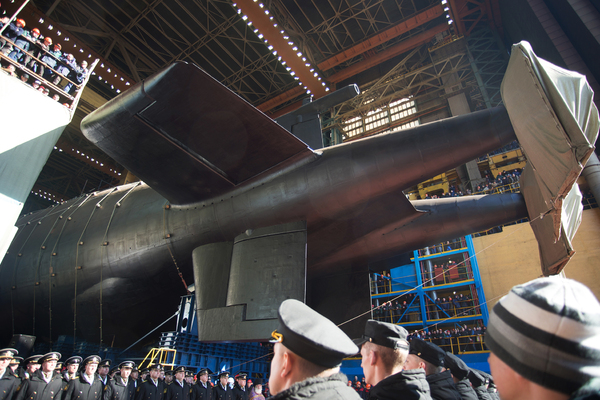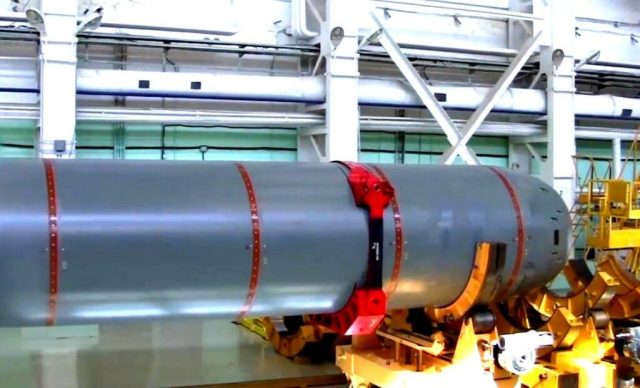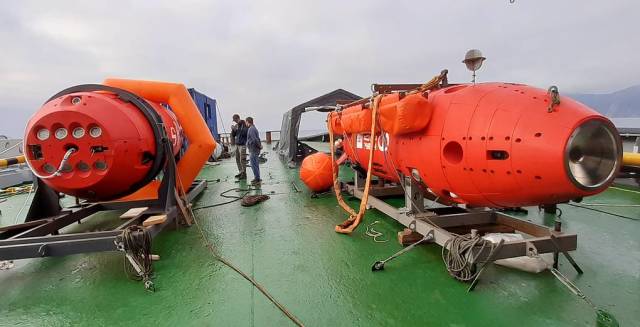Dmitry Litovkin, editor-in—chief of the TASS magazine "Military-Technical Cooperation" - what is known about the new BS-329 nuclear submarine
 |
| The ceremony of launching the Belgorod nuclear submarine in Severodvinsk. |
| Source: Photo: Oleg Kuleshov / TASS |
The largest and most secret ship of the Navy (Navy) of the Russian Federation - the BS—329 Belgorod nuclear submarine - has started performing combat missions. The ceremony of handing over the submarine took place on July 8 at the largest shipbuilding enterprise in Russia — PO Sevmash (part of the United Shipbuilding Corporation) in Severodvinsk.
The submarine was created on the basis of the 949th Antey-type submarine —carrier of supersonic anti-ship cruise missiles P-700 Granit. However, during construction, the submarine underwent serious changes: in the central part, where the missiles were previously placed, an additional 30-meter compartment was embedded: the length of the nuclear-powered vessel was more than 180 m. This is 11 m more than the largest, listed in the Guinness Book of Records, submarine 941 "Typhoon" (in the Soviet Union they were called "Sharks"), and 12 m more than the American Ohio—type submarine. The purpose of the BS-329 modification, according to many experts, was the possibility of using the AS-31 Losharik deep-sea vehicle together with the ship, as well as the Poseidon Doomsday torpedoes.
Approach and attack
The Belgorod submarine will become the first boat of the Main Directorate of Deep—Sea Research of the Ministry of Defense of the Russian Federation - a structure no less secret than the ship itself. It is believed that this is the "underwater special forces" of Russia, which is directly subordinate to the Minister of Defense. However, the unit also performs research missions. In the context of the Belgorod submarine, this is especially emphasized.
Initially, the nuclear-powered vessel was created to fight surface aircraft carrier groups of the enemy. He was supposed to carry 20 P-700 Granit cruise missiles on board. It was planned that the submarine would become the 14th in the family of submarines of projects 949 and 949A. However, after the collapse of the USSR, the construction of the ship was frozen — there were no funds, and the concept of confrontation with the Americans at that time underwent serious changes. On December 20, 2012, the construction of the submarine resumed, but according to the new project 09852.
On April 23, 2019, the boat was taken out of the boathouse for completion afloat and testing. According to various photos in the public domain, it can be judged that another submarine is docked to the bottom of the submarine — most likely, these are various autonomous deep-water stations (AGS).
So, at the ceremony of raising the St. Andrew's flag, the Commander-in-chief of the Navy Nikolai Evmenov said: "The Belgorod submarine opens up new opportunities for Russia in conducting various studies, allows for diverse scientific expeditions and rescue operations in the most remote areas of the World Ocean." It can be concluded that the AS-31 Losharik will become such an AGS — the only nuclear submarine in the world capable of diving to 6 thousand meters (for the rest, the limit is up to a thousand).
The existence of the secret AS-31 became known in 2003 from the publication of the newspaper "Shipbuilder", produced by the plant "Sevmash", where the device was built. In the same article, the unofficial name "Losharik" was mentioned. According to the publication, the workers so called the new submarine because its sturdy hull of several spherical compartments looked like a toy horse made of balls - the hero of a popular cartoon in the 1970s and 1980s. This does not detract from its technical capabilities at all — on the contrary, due to the fact that its body is assembled from spherical compartments, it is able to withstand monstrous water pressure at great depth.
According to open sources, the submarine AC-31 belongs to the project 1083, was launched in 2003. It is also known that its length is 60 m, it has one nuclear reactor that allows it to reach a speed of 30 knots (about 60 km / h) under water.
 |
| "Poseidon." |
| Source: Russian Defense Ministry |
The "Doomsday torpedo" Poseidon was presented in a message to the Federal Assembly by President Vladimir Putin in 2018. Very little is known about it either — nuclear, autonomous. It is believed that this is a kind of reincarnation of the T-15 product designed by Andrei Sakharov, a machine with a length of 25 m and a diameter of over 1.5 m. According to the plan, the torpedo should be able to deliver weapons at a distance of about a couple of hundred kilometers from the intended object, for example, some overseas city, and attack at the right moment. The explosion of such a product would cause a tsunami, which would destroy the city.
In addition, in 2018, a TASS source reported that "various nuclear charges can be installed on the new torpedo, a monoblock thermonuclear warhead similar to the Avangard charge will have maximum power — up to two megatons in TNT equivalent." Then it was clarified that in nuclear equipment the device would be "intended primarily for the destruction of fortified naval bases of a potential enemy."
Thanks to the nuclear power plant, the agency interlocutor said, Poseidon will go to the target at an intercontinental range at a depth of more than 1 km at a speed of 60-70 knots (110-130 km/h). And here it is important to clarify that, according to open sources, for example, there are nuclear warheads with a capacity of about 150 kt on an intercontinental ballistic missile of the Yars type. And now you can calculate: the standard nuclear warhead dropped on Hiroshima and Nagasaki had a power of 20 kt and destroyed everything within a radius of more than 10 km.
Rising from the depths
In April 2021, a TASS source reported that Belgorod would serve in the Pacific Fleet. The place of its permanent basing will be the main base of the submarine fleet in Vilyuchinsk. It is there that our most modern nuclear submarines of Project 955 ("Borey") are located, and the Novosibirsk submarine will also enter combat service soon — it will become the first submarine of project 885 M ("Yasen-M") in the combat composition of the Pacific Fleet.
A couple of years ago, it was from this place that the expedition of the Foundation for Advanced Research (FPI) was organized on the rescue tug "Photius Krylov" with the deep-sea vehicle "Vityaz-D" on board. The FPI then said that the autonomous device collected purely scientific information, one of which was mapping the bottom relief. Igor Vilnit, General Director of the Central Design Bureau of MT Rubin, one of the world leaders in submarine design and the leading design bureau of underwater shipbuilding in Russia, told TASS that he did it "according to a program assignment" that was introduced by the operator of the device before diving. But there was another nuance — Vityaz constantly communicated with the surface, and he did it not via fiber-optic cable, but via an autonomous communication channel.
 |
| ANPA "Vityaz-D" on the deck of the rescue vessel of the Pacific Fleet "Photius Krylov". |
| Source: © Press Service of the Foundation for Advanced Studies |
The underwater drone went offline from Kamchatka to the Mariana Trench. From a depth of 12 km, he transmitted information about what he saw by radio signal, and in fact was engaged not only in collecting hydrobionts, but also in mapping the terrain. The depression is the deepest fault of the planet — in military terms, a "highway" that takes any robot to the American Air Force and Navy base on the island of Guam. It is hard to imagine that Poseidon will not receive data from Vityaz-D. And there is no doubt that he will be able to wait for years for a signal for combat use at a depth of tens of kilometers.
One of the confirmations of this opinion may be the exercises in which, again, according to indirect data from Internet bloggers, the BS-329 Belgorod participated - the ship was photographed when leaving Severodvinsk. A little later, the press service of the Northern Fleet reported that a group of ships began testing submarine systems and weapons at a maximum depth of 500 m in the Barents and Norwegian Seas. "The crews of several submarines, including the fourth generation, are taking part in the exercises," the press service noted at the time.
In addition to Poseidon, several more underwater robotic systems have been created or are being created in Russia: the autonomous uninhabited apparatus "Klavesin-2R-PM". It is capable of carrying out research and search operations at a depth of up to 6 thousand meters — the main depth of the World Ocean. For example, it can search for sensors of underwater surveillance systems located at the bottom of the sea. It is curious that the hangar for this product is necessarily present on the publicly available images of Belgorod.
Dmitry Litovkin
The opinion of the editorial board may not coincide with the opinion of the author. Quoting is allowed with reference to tass.ru
